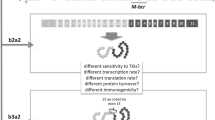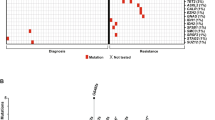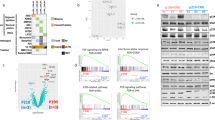Abstract
Mutations of the BCR-ABL kinase domain are a common mechanism of resistance to imatinib in chronic myeloid leukemia. We screened for mutations 171 patients failing imatinib therapy. Sixty-six mutations in 23 amino acids were identified in 62 (36%) patients not responding to imatinib. Phosphate-binding loop (P-loop) mutations were the most frequent (n=24; 36%). By multivariate analysis, factors associated with development of mutations were older age (P=0.026) prior interferon therapy (P=0.026), and accelerated phase or blast phase at time of imatinib failure (P=0.001). After a median follow-up of 38 months (range, 4–68 months) from the start of imatinib therapy, seven patients with non-P-loop and two with P-loop mutation died. By multivariate analysis, development of clonal evolution and higher percentage of peripheral blood basophils were associated with worse survival from the time of imatinib failure. Mutation status had no impact on survival. When survival was measured from the time therapy started, non-P-loop mutations together with duration of response and transformation at the time of failure to imatinib were associated with shorter survival. In conclusion, P-loop mutations were not associated with poor outcome, suggesting that the prognosis of patients who fail imatinib is multifactorial.
This is a preview of subscription content, access via your institution
Access options
Subscribe to this journal
Receive 12 print issues and online access
$259.00 per year
only $21.58 per issue
Buy this article
- Purchase on Springer Link
- Instant access to full article PDF
Prices may be subject to local taxes which are calculated during checkout


Similar content being viewed by others
References
Goldman JM, Melo JV . Chronic myeloid leukemia – advances in biology and new approaches to treatment. N Engl J Med 2003; 349: 1451–1464.
Cortes J, Talpaz M, O’Brien S, Jones D, Luthra R, Shan J et al. Molecular responses in patients with chronic myelogenous leukemia in chronic phase treated with imatinib mesylate. Clin Cancer Res 2005; 11: 3425–3432.
Hughes TP, Kaeda J, Branford S, Rudzki Z, Hochhaus A, Hensley ML et al. Frequency of major molecular responses to imatinib or interferon alfa plus cytarabine in newly diagnosed chronic myeloid leukemia. N Engl J Med 2003; 349: 1423–1432.
Hochhaus A, Kreil S, Corbin AS, La Rosee P, Muller MC, Lahaye T et al. Molecular and chromosomal mechanisms of resistance to imatinib (STI571) therapy. Leukemia 2002; 16: 2190–2196.
Gambacorti-Passerini CB, Gunby RH, Piazza R, Galietta A, Rostagno R, Scapozza L . Molecular mechanisms of resistance to imatinib in Philadelphia-chromosome-positive leukaemias. Lancet Oncol 2003; 4: 75–85.
Gorre ME, Mohammed M, Ellwood K, Hsu N, Paquette R, Rao PN et al. Clinical resistance to STI-571 cancer therapy caused by BCR-ABL gene mutation or amplification. Science 2001; 293: 876–880.
Branford S, Rudzki Z, Walsh S, Parkinson I, Grigg A, Szer J et al. Detection of BCR-ABL mutations in patients with CML treated with imatinib is virtually always accompanied by clinical resistance, and mutations in the ATP phosphate-binding loop (P-loop) are associated with a poor prognosis. Blood 2003; 102: 276–283.
Gambacorti-Passerini C, Zucchetti M, Russo D, Frapolli R, Verga M, Bungaro S et al. Alpha1 acid glycoprotein binds to imatinib (STI571) and substantially alters its pharmacokinetics in chronic myeloid leukemia patients. Clin Cancer Res 200; 9: 625–632.
Donato NJ, Wu JY, Stapley J, Lin H, Arlinghaus R, Aggarwal BB et al. Imatinib mesylate resistance through BCR-ABL independence in chronic myelogenous leukemia. Cancer Res 2004; 64: 672–677.
Donato NJ, Wu JY, Stapley J, Gallick G, Lin H, Arlinghaus R et al. BCR-ABL independence and LYN kinase overexpression in chronic myelogenous leukemia cells selected for resistance to STI571. Blood 2003; 101: 690–698.
Branford S, Rudzki Z, Walsh S, Grigg A, Arthur C, Taylor K et al. High frequency of point mutations clustered within the adenosine triphosphate-binding region of BCR/ABL in patients with chronic myeloid leukemia or Ph-positive acute lymphoblastic leukemia who develop imatinib (STI571) resistance. Blood 2002; 99: 3472–3475.
Soverini S, Martinelli G, Rosti G, Bassi S, Amabile M, Poerio A et al. ABL mutations in late chronic phase chronic myeloid leukemia patients with up-front cytogenetic resistance to imatinib are associated with a greater likelihood of progression to blast crisis and shorter survival: a study by the GIMEMA working party on chronic myeloid leukemia. J Clin Oncol 2005; 23: 4100–4109.
Nardi V, Azam M, Daley GQ . Mechanisms and implications of imatinib resistance mutations in BCR-ABL. Curr Opin Hematol 2004; 11: 35–43.
Corbin AS, Rosee PL, Stoffregen EP, Druker BJ, Deininger MW . Several Bcr-Abl kinase domain mutants associated with imatinib mesylate resistance remain sensitive to imatinib. Blood 2003; 101: 4611–4614.
Branford S, Rudzki Z, Parkinson I, Grigg A, Taylor K, Seymour JF et al. Real-time quantitative PCR analysis can be used as a primary screen to identify patients with CML treated with imatinib who have BCR-ABL kinase domain mutations. Blood 2004; 104: 2926–2932.
Kantarjian H, Sawyers C, Hochhaus A, Guilhot F, Schiffer C, Gambacorti-Passerini C et al. Hematologic and cytogenetic responses to imatinib mesylate in chronic myelogenous leukemia. N Engl J Med 2002; 346: 645–652.
Kantarjian HM, Cortes J, O’Brien S, Giles FJ, Albitar M, Rios MB et al. Imatinib mesylate (STI571) therapy for Philadelphia chromosome-positive chronic myelogenous leukemia in blast phase. Blood 2002; 99: 3547–3553.
Kantarjian HM, O’Brien S, Cortes JE, Smith TL, Rios MB, Shan J et al. Treatment of Philadelphia chromosome-positive, accelerated-phase chronic myelogenous leukemia with imatinib mesylate. Clin Cancer Res 2002; 8: 2167–2176.
Kantarjian HM, Talpaz M, O’Brien S, Smith TL, Giles FJ, Faderl S et al. Imatinib mesylate for Philadelphia chromosome-positive, chronic-phase myeloid leukemia after failure of interferon-alpha: follow-up results. Clin Cancer Res 2002; 8: 2177–2187.
Kantarjian HM, Smith T, O’Brien S, Beran M, Pierce S, Talpaz M et al. Prolonged survival in chronic myelogenous leukemia after cytogenetic response to interferon-therapy. Ann Int Med 1995; 122: 254–261.
Snedecor G, Cochran W . Statistical Methods. 7th edn. Iowa State University Press, Ames, Iowa, 1980.
Agresti A . Categorical Data Analysis. 2nd edn. John Wiley & Sons Inc. Hoboken, NJ, 1990.
Kaplan EL, Maier P . Non-parametric estimation from incomplete observations. J Am Stat Assoc 1965; 53: 457–481.
Cox DR . Regression models and life tables. J R Stat Soc 1972; 34: 187–220.
Cortes J, Giles F, O’Brien S, Thomas D, Garcia-Manero G, Rios MB et al. Result of high-dose imatinib mesylate in patients with Philadelphia chromosome-positive chronic myeloid leukemia after failure of interferon-{alpha}. Blood 2003; 102: 83–86.
Kantarjian H, Talpaz M, O’Brien S, Garcia-Manero G, Verstovsek S, Giles F et al. High-dose imatinib mesylate therapy in newly diagnosed Philadelphia chromosome-positive chronic phase chronic myeloid leukemia. Blood 2004; 103: 2873–2878.
Soverini S, Martinelli G, Rosti G, Bassi S, Amabile M, Poerio A et al. ABL mutations in late chronic phase chronic myeloid leukemia patients with up-front cytogenetic resistance to imatinib are associated with a greater likelihood of progression to blast crisis and shorter survival: a study by the gimema working party on chronic myeloid leukemia. J Clin Oncol 2005, JCO.2005.2005.2531.
Shah NP, Nicoll JM, Nagar B, Gorre ME, Paquette RL, Kuriyan J et al. Multiple BCR-ABL kinase domain mutations confer polyclonal resistance to the tyrosine kinase inhibitor imatinib (STI571) in chronic phase and blast crisis chronic myeloid leukemia. Cancer Cell 2002; 2: 117–125.
Willis S, Lange T, Demehri S, Otto S, Crossman L, Niederwieser D et al. High sensitivity detection of BCR-ABL kinase domain mutations in imatinib-naive patients: correlation with clonal cytogenetic evolution but not response to therapy. Blood 2005, 2005-2003-1036.
Jabbour E, Cortes J, Kantarjian HM, Giralt S, Jones D, Jones R et al. Allogeneic stem cell transplantation for patients with chronic myeloid leukemia and acute lymphocytic leukemia after BCR-ABL kinase mutation-related imatinib failure. Blood 2006 [E-pub ahead of print (April 6, 2006)].
Roche-Lestienne C, Lai JL, Darre S, Facon T, Preudhomme C . A mutation conferring resistance to imatinib at the time of diagnosis of chronic myelogenous leukemia. N Engl J Med 2003; 348: 2265–2266.
O’Hare T, Walters DK, Stoffregen EP, Jia T, Manley PW, Mestan J et al. In vitro activity of Bcr-Abl inhibitors AMN107 and BMS-354825 against clinically relevant imatinib-resistant Abl kinase domain mutants. Cancer Res 2005; 65: 4500–4505.
Author information
Authors and Affiliations
Corresponding author
Rights and permissions
About this article
Cite this article
Jabbour, E., Kantarjian, H., Jones, D. et al. Frequency and clinical significance of BCR-ABL mutations in patients with chronic myeloid leukemia treated with imatinib mesylate. Leukemia 20, 1767–1773 (2006). https://doi.org/10.1038/sj.leu.2404318
Received:
Revised:
Accepted:
Published:
Issue Date:
DOI: https://doi.org/10.1038/sj.leu.2404318
Keywords
This article is cited by
-
Occurrence of Existing BCR-ABL Baseline Mutations and Associated Haplotype (NmR) Among CML Patients with Diverse IM Response: A Hospital-based Study from North-East India
Biochemical Genetics (2024)
-
Effects of ABCG2 C421A and ABCG2 G34A genetic polymorphisms on clinical outcome and response to imatinib mesylate, in Iranian chronic myeloid leukemia patients
Egyptian Journal of Medical Human Genetics (2023)
-
Overcoming BCR::ABL1 dependent and independent survival mechanisms in chronic myeloid leukaemia using a multi-kinase targeting approach
Cell Communication and Signaling (2023)
-
ABL1 tyrosine kinase domain mutations in chronic myeloid leukemia treatment resistance
Molecular Biology Reports (2019)
-
Molecular Mechanisms of Resistance to Tyrosine Kinase Inhibitors
Current Hematologic Malignancy Reports (2019)



